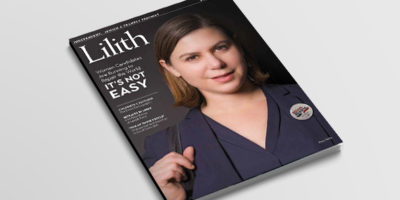Some Never Noticed They Were Jewish
Reading through Rachel Blau du Plessis and Ann Snitow’s anthology The Feminist Memoir Project almost a decade ago, I was struck by the essay “Our Gang of Four: Female Friendship and Women’s Liberation,” written by Amy Kesselman with Heather Booth, Vivian Rothstein, and Naomi Weisstein, members of the nation’s first women’s liberation group. The article posited that friendships like theirs formed a pivotal part of second-wave feminism, becoming the matrix for its revolutionary ideas. Though it included sections on the women’s family histories and their involvement in the social movements of the 1960s, it did not mention the women’s Jewishness (except in the case of Rothstein, who was the daughter of Holocaust refugees.) Until I contacted the women, in fact, they had never spoken about their Jewish backgrounds to each other! It turned out that this was also true of Jewish women in other collectives that I began to research. Historians of women’s liberation were not writing about the significance of Jewish women’s participation in the movement either.
As an historian of women and gender focusing on American Jewish women, I have long been interested in telling the story of American Jewish women’s activism. Jewish women’s contributions to radical feminism are a missing chapter in that story.
Radical feminism (also known as “women’s liberation”) began in the late 1960s following by a few years the onset of second-wave’ “liberal” (or “equal rights”) feminism. Demanding a radical restructuring of culture and society rather than the more piecemeal reforms associated with liberal feminism, it brought us consciousness-raising, “sisterhood is powerful,” “the personal is political,” and a variety of other organizing tools and perspectives to wage war against male oppressions. But while we now know a great deal about Jewish women’s participation in liberal feminism, as well as in the civil rights and labor movements, and other, earlier social justice campaigns, we remain ignorant of their roles in women’s liberation. I wrote Jewish Radical Feminism to correct this omission and create a more inclusive narrative of both women’s history and American Jewish history.
My narrative includes two major groups of radical Jewish feminists that historians usually keep separate. One category is made up of major women’s liberationists collectives that did not specifically identify as Jewish, such as the West Side Group in Chicago, Redstockings in New York, Boston’s Bread and Roses, and the Boston Women’s Health Book Collective (which created Our Bodies, Ourselves). I found that in some of these collectives as many as three-quarters of the participants were Jewish. The Jewishness of these groups was an open secret for some participants, suspected but not explicitly recognized. In other cases, Jewish identity remained invisible, submerged, ignored, or rejected. This is largely because the women prioritized their universalist goals, dreaming of a common sisterhood, and deemphasized their own (and potentially divisive) ethnic or religious origins.
Part Two of the book chronicles the stories of women in self-consciously Jewish-identified collectives, both ones that were religious––like Ezrat Nashim, in New York—and those that were secular, like Chicago’s Chutzpah, New York’s Brooklyn Bridge, and the lesbian collective that gave itself the Yiddish name Di Vilde Chayes, the wild beasts. Believing that liberation required the overthrow of patriarchal institutions within Jewish culture, these women sought a feminist transformation of Jewish institutions or the creation of new Jewish feminist organizations and enterprises (including Lilith). Sometimes the women were considered as a “friendly” opposition, but they often faced opprobrium from within the Jewish community for their rebellions. Other groups of Jewish feminists came to organize around their Jewishness out of concern over the threat of anti-Semitism within the feminist movement as well as in general society. But in my interviews with dozens of Jewish women’s liberationists, no matter whether their Jewishness was front and center or was elided, the deep influence of Jewish background and values clearly emerged, enhancing and helping to motivate feminist activism.
Even among women’s liberation and Jewish feminist groups with shared perspectives and common pasts, I found the depth and variety of Jewish backgrounds striking. To represent the range of such diverse lives, I organize the book around “side-by-side” profiles, creating a gallery of individuals and groups rather than a few essential types. Each individual narrative is an amalgam of the woman’s heritage, personality, and social and historical location. Together these profiles offer new information about the construction of what we now see as intersectional identities.
I tell the Jewish/feminist stories of over 40 individuals—among them Heather Booth, Shulamith Firestone, Ellen Willis, Alix Kates Shulman, Susan Brownmiller, Meredith Tax, Diane Balser, and six Jewish women of Our Bodies, Ourselves. Among the more Jewish-identified feminists are Martha Ackelsberg, Arlene Agus, Judith Plaskow, Rabbis Rebecca Alpert and Laura Geller, Blu Greenberg, Aviva Cantor, Cheryl Moch, Susan Weidman Schneider, Maralee Gordon, Evelyn Torton Beck, Irena Klepfisz, Melanie Kaye/Kantrowitz, Gloria Greenfield, Adrienne Rich, Marcia Freedman, Letty Cottin Pogrebin, Phyllis Chesler, and Galia Golan.
Despite the broad array of opinions and experiences that fill the book’s pages, I see and name a set of common characteristics that depict the special nature of twentieth-century American Jewish radical feminism. While the women occupy a historical moment shared with other radical feminists, they are also defined by their unique heritage as Jews. We see that this legacy played a major role in shaping one of the most transformative political and social movements of our era, generating far-reaching changes in all spheres of life and in the understanding of gender.
From consciousness-raising groups, to health collectives, to militant lesbians and women standing up to religious patriarchy, historian Antler spends time with the dozens of Jewish personalities of radical feminist movements—women who challenged the structure of society far beyond the reach of laws.



